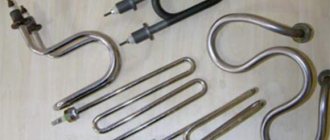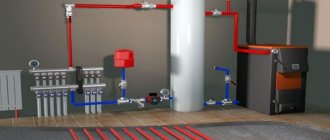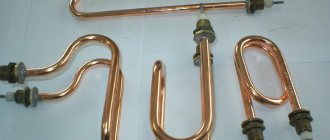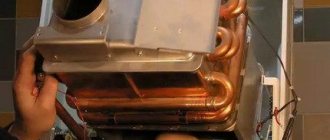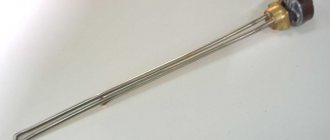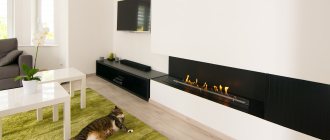Here you will learn:
- What is a biofireplace
- What is biofuel
- Advantages of biofuel fireplaces
- Construction and design of a biofireplace
- Types of fireplaces and their costs
- Choosing a biofireplace
- Installation of a biofireplace
- Types of biofuels and their features
- Biofuel consumption and operating efficiency
- How to make biofuel yourself
- Rules for the safe operation of a biofireplace
Biofuel fireplaces are a modern, environmentally friendly, safe and stylish design element or structure for heating a room. These fireplaces run on biofuel. They can be installed on the floor, on a table, on a wall, or built into a classic fireplace.
What is a biofireplace
Why do owners increasingly choose biofireplaces? It's simple. A fireplace with biofuel operates on a biostandard - it is an environmentally friendly fuel. For such a device, you will not need to prepare firewood, look for a place to store it, and there will be no soot, soot, or debris near the heating device.
The composition of biofuel for fireplaces is simple; it contains purified alcohol, which is obtained after processing plants. When such fuel burns, there are no emissions of soot and various toxic elements.
As a result of combustion, everything breaks down into carbon dioxide and water vapor. A little carbon dioxide is released. Thanks to this content, there is no need to install ventilation in the house.
Just a note! If you need to install a fireplace in a small room, then it is better to choose a device that runs on biofuel. There will be no contamination and the design itself is much simpler.
Do-it-yourself production of biofireplaces
In most cases, people decide to make a biofireplace with their own hands, having familiarized themselves with the models presented in the store and their prices. Having studied how a bio-fireplace works, you can immediately understand that there is nothing complicated in this system.
The device always consists of four basic blocks:
- frame for fastening elements;
- protective screen made of fire-resistant glass;
- fuel tank for bioethanol;
- burners.
If desired, a portal is mounted around the system, which allows you to fully integrate a biological fireplace into the interior, as usually happens with the classic version.
But despite all the simplicity, the cost of such devices is quite high, which is why in most cases it is more profitable to assemble a biofireplace with your own hands. In addition, a device you make yourself will become not only an excellent piece of furniture, but also your pride. You don’t have to make any extra efforts for this; simple skills in handling tools are enough, and all materials for a bio-fireplace can be easily purchased in suitable stores.
Hanging version of eco-fireplace
To assemble a biofireplace with your own hands, you need to prepare the following materials:
- To make a protective screen you will need glass. It is best to choose the hardened version, but in most cases the regular one will do just fine. The thickness should be chosen from 4-5 mm, this will be enough. You can buy a large piece and cut it yourself, but it is better to contact a glass shop, tell them the dimensions, and ask them to polish the edges. In this form, the glass for the bio-fireplace will look much prettier. In addition, in the workshop you can consult on methods for attaching the protective screen, because you can install it without gluing, or you can connect all the glass with sealant. The experts will tell you which heat-resistant sealant to choose.
- Metal containers and cans are usually chosen for the burner and fuel tank. In some cases, the fuel tank, frame and burner are a single unit, but it is best to provide an additional iron container that you will install inside the frame. The fuel block can be considered the main element of the system. Fuel should not leak out; the tightness must be at a high level. You can make a fuel tank for a biofireplace with your own hands by cutting out a metal tank and welding it together.
- To create a distributed fire that will occupy the space allotted to it, you will need a metal stack. The mesh is installed on the fuel tank. It is desirable that the cells in the grid be small; in extreme cases, you can fold the grid several times.
- The fire is brought to the grid using a wick, which can be an ordinary durable fabric cord. The wick for a bio-fireplace connects the fuel tank to the mesh, bringing the fire out.
- To decorate a biofireplace you will need appropriate elements. You can use stones, pebbles, ceramic imitation coals, firewood, and so on. Decorative elements are loaded inside the biofireplace, directly onto the mesh.
For the system to fully operate, biological fuel is required. You can buy it in the relevant stores. Of course, you can make biofuel yourself, but you won’t save much from it, so it’s easier and faster to use a ready-made option.
You can find everything you need for a biofireplace in stores; there are no secret elements in its design.
This is interesting: Wall-mounted fireplace (51 photos) - Electrolux model in the interior, round and flat fireplaces
What is biofuel
For the operation of eco-fireplaces, special combustible compositions are used, obtained from the processing of biological waste or made from plant materials. It gives a beautiful “live” flame without sparking, odors, soot and smoke.
The most common type of fuel is denatured ethanol. Additionally, it is enriched with special additives that color the fire a warm orange color.
And for those who want to enjoy the complete illusion of a fire with the characteristic crackling of firewood, there are special biogels that contain sea salt.
Ecofuel is sold in the form of a liquid or jelly-like gel in cans, bottles or canisters with a capacity of 1 to 5 liters, and the compositions can be flavored or neutral
The composition of industrial ecofuels should contain at least 95% bioethanol, 3-4% water and 1-2% various additives (for example, methyl ethiketone or bitrex), which prevent the mixture from separating into water and alcohol and give a beautiful color to the flame.
To choose the right fuel for your fireplace, focus on the heating performance of the fuel (on average, about 6.5 kW/h of heat is generated when burning 1 liter) and the availability of a quality certificate.
Although regular alcohol can be used as fuel for a fireplace, its bluish flame cannot be compared with the warm fire characteristic of burning wood that bioethanol produces
But if you wish, you can make the dressing mixture yourself.
For this you will need:
- Purified 96 percent ethyl alcohol with a colorless flame - 1 liter.
- Gasoline with a high octane number, for example, “Galosha” (simple automobile gasoline will not work - a characteristic odor will be released when burning) - 50 ml.
- Aromatic additives from essential oils (optional) – 5-7 drops.
Then you need to mix the liquids in the specified proportions, shake until smooth and pour into the burner or fuel block.
The disadvantage of this method is that the flammable composition is suitable for use only immediately after preparation; it will not be possible to make a reserve for long-term storage - the mixture will separate.
What to look for when choosing?
Although buyers are most often guided by the appearance of the device and its compliance with the interior design, they should not lose sight of the technical characteristics of the device.
The longer the fireplace burner, the more area it can heat, and if you plan to use the device as an additional heat source, consider options with a power of 3 kW or more
Important parameters:
- The power of the biofireplace varies from 1 to 7 kW. The higher this indicator, the greater the heat transfer from the device, as well as the brighter the flame and the higher the column of fire. But the consumption of expensive fuel increases proportionally.
- Fuel tank volume – from 50 ml to 9 liters. Of course, a device with a large capacity functions longer without refilling, but since it is not recommended to leave unused liquid in the device, it is worth estimating the actual operating time of the fireplace before purchasing.
- Burner material - for safe operation of the device, this element must be made of high-quality stainless steel 3-5 mm thick or ceramics.
- Double circuit burner – provides additional thermal insulation and controls the fuel level. For example, if you pour a lot of fuel, its excess will “go” into the second circuit and will be consumed only after the liquid is burned in the first.
But fuel consumption, which is often of interest to buyers, is a very relative value, because much depends on the power of the device, the size of its tank and the specified flame power. In an hour, an average-sized fireplace can consume from 350 ml to 1 liter of combustible mixture, so many manufacturers indicate either a consumption “fork” or the required minimum for starting.
Advantages of biofuel fireplaces
Let's talk about the main advantages of biofuel fireplaces and how the modern system works.
- Let's start with the fact that a biofireplace is a version of a home fireplace with a live fire that “plays” in a glass space, which ensures safety for surrounding people (especially children and animals) and furniture.
- Installing a bio-fireplace is a mere trifle compared to its “wood-burning” version. An eco-fireplace does not require a smoke exhaust system.
- The fuel for the fireplace is biologically pure liquid fuel - this is alcohol, which burns without residue and does not in any way harm the health of others. The combustion temperature of the fuel is low, and the evaporation of carbon dioxide is so small that a regular candle can be considered a more dangerous source of heat.
- Fuel for the fireplace is freely available, and there is no need to allocate a separate room for its storage (for example, as with firewood).
- A wide variety of eco-fireplace models allows you to create the kind of interior you have long dreamed of. Individual fireplace models are selected in accordance with the design of the room where the fireplace will be located.
- The use of a biofireplace does not imply the presence of soot and dirt.
- Such fireplaces are affordable.
- A biofireplace without a chimney is an excellent source of heat.
- And most importantly, perhaps, their advantage is that a biofireplace can be easily installed in your own, even not too large, apartment.
What are the advantages of a biofireplace
1. Environmental friendliness. It is not by chance that we put this advantage in first place. Considering how the environmental situation is developing today (deforestation, reduction of natural resources, air pollution), liquid fuel fireplaces are a very promising analogue of wood-burning hearths.
2. Versatility. You can install an eco-fireplace in almost any room. In this case, it is important to take into account its area and intelligently correlate it with the line of fire.
There are no strict restrictions for installing a biofireplace.
Even for a room less than 10 square meters. m will have its own tabletop mini-hearth.
3. Simple and quick installation. Many models are delivered assembled and ready to go straight away. Built-in fireplaces are more labor-intensive, but they can also be installed on your own.
4. Security. The design of the bio-fireplace is thought out in such a way as to completely prevent fire from escaping beyond its boundaries (if the instructions are followed). In other words, to start a fire, you have to try!
The bio-fireplace can even be combined with wood trim and wallpaper.
Its flame temperature reaches 450 °C, which is 2 times less than that of a wood-burning fireplace.
5. Easy operation. The eco-fireplace does not require any maintenance, and it works properly for decades. The rules of use are extremely simple. Caring for the device is simple: you just need to wipe off dust from the case, remove fingerprints and stains from the protective glass.
Construction and design of a biofireplace
The design of an eco-fireplace consists of a fuel module and a decorative body (metal, stone, glass-ceramic or any heat-resistant material).
The device body can be either open or closed. The flames are insulated with fireproof glass in the form of a protective screen.
The firebox looks like a burner or is a fuel block - a more complicated device. For a fuel module, the most important indicator is its power, by which the power of the device itself is judged.
The operation of an eco-fireplace begins with filling the heating tank with fuel and lighting the wick. The flame is even and bright, and there is no smoke from the chimney. The intensity of combustion is regulated by a special grille (slider).
A distinctive feature of a biofuel fireplace without a chimney is that it will take only about twenty minutes to heat a room measuring one hundred square meters.
Device
The most important part of a biofireplace is the burner. The base and firebox, unlike real appliances, are only decorative elements. Often the burner can be purchased separately. It is installed in the combustion hole in the fireplace or false fireplace. This design allows you to easily transform an ordinary device into a biofireplace.
There are two main zones in the biofireplace. These include:
- Furnace part.
- Decorative elements.
Decoration
The devices are decorated in different ways. Style is possible from classic to hi-tech.
Traditional models are decorated with strict portals, or a frame can be made of wood, metal, or stone. The burner is often hidden in a chamber behind glass facades.
There are many designer exclusive bio-fireplaces. Original unusual shapes of different sizes, any colors, made from various materials. Often styles and functions are mixed and very interesting products are obtained.
You can design a bio-fireplace with your own hands. There is also the opportunity to make biofuel yourself.
Need to know! You can make biofuel yourself, but it is better to buy it ready-made. At home, it is not always possible to accurately calculate the proportions of alcohol and other components.
Design options
The functional filling of the bio-fireplace is not tied to decorative design elements and the body, which allows you to create individual, unique combinations. The developers follow trends in the field of decor to offer customers cutting-edge, stylish design.
Such areas are in great demand among ordinary buyers and interior designers.
- High-tech – functional minimalistic design in neutral contrasting colors. This style symbolizes the seriousness, rigor and progressiveness of the owner.
- Baroque - pompous sophistication with decoration from elite materials. It has a defiant sophistication and is suitable for bio-fireplaces, which will become the central figure of the interior.
- Classic – imitation of a traditional fireplace, providing high similarity. In addition to decoration, decorative elements for the hearth are used: replicas of logs, stones
- Country is unbridled primitiveness and brutality. The effect is created by natural materials - stone and wood.
- Boho – decoration with intricate carvings creates a festive atmosphere. It has a rich texture, rich colors and is ideal for vintage interiors. Boho expresses the freedom and creativity of the wearer.
- BIO - the naturalness of fire is emphasized with a matte finish and pebbles. For decoration, light natural tones are used to imitate the texture of wood or stone. An excellent solution for rooms with “green” areas.
- Shabby chic is the artificial “aging” of a portal to create a feeling of restoration. The ideal complement to such a fireplace would be a rocking chair, sets, figurines and paintings, but without unnecessary pathos.
Please note that the style is created not only by the decoration, but also by the decorative elements used. Rice
9. Wall-mounted bio-fireplace integrated into the interior of the apartment
Rice. 9. Wall-mounted bio-fireplace integrated into the interior of the apartment
Types of fireplaces and their costs
The first type of fireplace is a floor-standing fireplace. It has gained great demand and popularity among the advanced urban population. In its production, manufacturers actively use high-quality glass, metal and durable marble. If we talk specifically about a wall-mounted fireplace, then it is considered the most effective and favorable, according to experienced specialists in this field of activity. The corner fireplace is particularly compact and versatile.
The outdoor fireplace has the most elongated body. A mini-fireplace serves as an additional and beautiful decorative element of a living space. The cost of floor-standing fireplaces varies up to two hundred thousand Russian rubles. The price of wall-mounted fireplaces starts from two hundred thousand Russian rubles. Corner fireplaces cost on average eighty thousand Russian rubles. The most inexpensive outdoor fireplaces and mini-fireplaces, their maximum price is sixty thousand Russian rubles. Also on sale now you can see numerous harmless biosuppositories, the price of which is approximately six thousand Russian rubles.
Types of environmentally friendly biofuels
The prefix “BIO” is now often added to labels based on the rules of successful marketing. Issues of preserving the environment and cleanliness are in fashion today throughout the planet. Bio-products, bio-cosmetics, bio-based detergents, purification and bio-energy stations and even bio-toilets. It also came to fireplaces and fuel for them.
Structurally, biofuel fireplaces are equipped with a standard burner and a tank for liquid fuel. Adjustment of the flame size and fuel combustion rate is carried out using a damper.
If it is completely closed, then the fire in the biofocus simply goes out by itself. In general, a bio-fireplace is a great way to heat a room and add a touch of coziness to it from the glow of the “bonfire”.
The biofireplace differs from its wood-burning ancestor in the fuel used to produce the flame - the logs in it are replaced with smokeless fuel in the form of a liquid
Obtaining biofuel for such a fireplace involves the use of renewable natural resources, environmentally friendly technologies and raw materials during production. Plus, burning it should not produce harmful emissions into the atmosphere. Humanity cannot yet survive without combustible fuel. But we can make it less harmful.
There are three types of biofuels:
- Biogas.
- Biodiesel.
- Bioethanol.
The first option is a direct analogue of natural gas, only it is not extracted from the bowels of the planet, but is produced from organic waste. The second is made by processing various oils obtained by squeezing oilseed plants.
As such, the fuel for biofireplaces is the third option - bioethanol. Biogas is mainly used to generate heat and electricity on an industrial scale, while biodiesel is more suitable for automobile internal combustion engines.
When burned, pure ethanol gives a blue, not very beautiful flame, so additives are added to fireplace biofuel to produce a red-yellow hue
Home fireplaces are most often fueled with bioethanol based on denatured alcohol. The latter is made from sugar (cane or beet), corn or starch. Ethanol is ethyl alcohol, which is a colorless and highly flammable liquid.
But most importantly, when burned, it does not emit odors, carbon monoxide and soot. Simply an ideal option for city apartments, in which it is almost impossible to install a chimney pipe.
Those who want to make a bio-fireplace with their own hands will be helped by a step-by-step guide, which we recommend that you read.
Choosing a biofireplace
The choice of a biofireplace begins with the choice of model, that is, with the design. There are built-in, floor-standing, suspended, wall-mounted and tabletop models. There is even a completely unique bio-fireplace called Flut, which is designed for use in swimming pools. It is simply immersed in water and either floats freely or is fixed in one position using a special stretching mechanism.
For the manufacture of bio-fireplaces, the following are used: alloyed corten steel (ultra-strong and corrosion-resistant steel), oxidized and stainless steel, varnished fiberglass, varnished MDF, heat-resistant glass, granite, tempered glass, genuine leather.
Each biofireplace model has one or more liquid biofuel burners built into it. The capacity of the burners can be from 2 to 10 liters. The materials from which the biofireplace is made and the characteristics of the burners included in it are indicated in the description of each model.
The variety of models, ease of installation and operation of biofireplaces, safety and exclusive design make biofireplaces very popular in the design of apartments, hotels, clubs, restaurants, offices, covered verandas and private pools.
Review of popular brands
Biodiesel for automobiles is mainly produced in America (USA, Canada and Brazil), as well as India, China and Europe. This is often presented as concern for the environment and increased use of alternative energy sources.
The output result is quite ambiguous. It’s one thing when waste is processed to make such fuel, and quite another thing is the processing of plants specially grown for this purpose.
The main ingredient of all brands of biofuel for fireplaces is alcohol; it does not have any particular differences in quality and composition between different manufacturers (+)
The situation with ethanol biofuel is somewhat different. It is produced on a much smaller scale. This is mainly done in Europe, but Russia also has its own factories. To produce this biofuel, raw materials of plant origin are also needed, but not in such huge volumes as in the case of the automobile analogue.
In domestic stores, you can choose fireplace biofuel from the following brands:
- Kratki BioDECO (Poland).
- InterFlame (Russia).
- BioKer (Russia).
- Planika Fanola (Germany).
- Vegeflame (France).
- Bionlov (Switzerland).
- Bioteplo Slimfire (Italy).
The choice is quite extensive. The price per liter ranges from 260–600 rubles. Cost often depends on the presence/absence and combination of additional additives. Some aromatic oils are quite expensive. Although they are present in biofuels in very small proportions, they still affect the price.
Installation of a biofireplace
Biofireplaces are the easiest appliances to install, as they do not require a chimney. Island models can be placed anywhere: on a table, chest of drawers, floor, veranda or in the garden. Wall-mounted biofireplaces require simple non-professional assembly, which will require fifteen minutes of free time and a regular screwdriver. The devices are mounted on a flat section of the wall.
If you decide to install a built-in bio-fireplace, you will need to carefully follow the installation instructions of the fireplace manufacturer and consider the fire resistance rating of the niche in which you will place it. Installation may vary from model to model, but any fireplace that runs on bioethanol will be ready for use immediately after installation.
Design Features
Construction of a biofireplace The
“Eco” model consists of two parts: a body (portal) and a fuel block. The housing can have different designs and shapes. Glass, stone, wood, steel, etc. are used to make it. Inside it there is a fuel block into which biofuel is poured. The fuel block may have a different volume, depending on the selected fireplace model. The internal design of the fuel blocks is also different. It can consist of two parts, separated by a partition, or have a complex structure in the form of a honeycomb.
Types of biofuels and their features
The prefix “bio” in the name of the fuel determines its environmental friendliness. After all, renewable natural resources are used in the production of this type of fuel. The main components used in the production of environmental fuel are grains and grasses with a high content of sugar and starch. Thus, cane and corn are the most suitable raw materials for creating biofuel.
Biofuel for biofireplaces, produced from natural components, is not inferior in its energy characteristics to the following less environmentally friendly analogues:
- biogas, which is a product of specific processing of various waste waste, like natural gas, is used to create thermal and mechanical energy;
- bioethanol, almost entirely consisting of alcohol, can replace gasoline;
- Biodiesel is made from vegetable oil for fueling cars and other purposes.
For lighting bio-fireplaces, preference is given to bioethanol, a colorless and odorless liquid. Among its advantages the following are noted:
- Environmental friendliness is due to the complete absence of carbon monoxide, soot and soot production.
- Easy to clean burners.
- High fire safety and reliable use of fuel due to thermal insulation of the fireplace body.
- No need to install ventilation devices.
- Convenience of transporting the fuel itself and ease of installation of the device.
- Possibility of adjusting combustion intensity.
- High heat dissipation.
- There is no need to prepare firewood or clean up dirt, debris and ash near the fireplace.
- The vapors released when ethyl alcohol is heated help normalize the humidity level in the room.
Ecological fuel
The name “biofuel” clearly reflects the concept of this product, created exclusively from biological raw materials. Biological raw materials mean fuel created in the process of processing waste products of vital activity of organisms, which can be of animal or plant origin. It is the prefix “bio” that confirms that plant raw materials were used in the fuel production process, which means the product is completely environmentally friendly.
It is believed that biofuel for a fireplace is one of the best types of fuel, which potentially does not even require a chimney. It is this fuel that is used to fire eco-fireplaces.
It is noteworthy that biofuel for fireplaces is denatured ethanol, created from simple ethanol in production. Ethanol is nothing more than alcohol obtained from sugar-rich plant materials, such as sugar cane, wheat, beets, and potatoes. Some types of fuel are created from alcohol obtained from cellulose raw materials and wood. Alcohol is obtained through the hydrolysis of cellulose.
Since pure alcohol is not allowed for sale, biofuel for biofireplaces and conventional models is created on the basis of denatured ethanol. Thus, we can conclude that the composition of biofuel is based on ordinary alcohol.
Biofuel consumption and operating efficiency
The average consumption of biofuel based on bioethanol is from 0.36 to 0.5 liters per hour. During the combustion of 1 liter of fuel, about 5 kWh of thermal energy is released. In terms of its performance, a biofireplace is similar to a standard electric heater with a power of 3 kW.
The main difference between the operation of these two heating devices is the ability to humidify the air when using a biofireplace, while a conventional electric heating device dries out the air very much.
The efficiency of a biofuel fireplace is about 95%. This fuel is very economical in consumption.
In order for a pleasant smell to appear in the room while the bio-fireplace is operating, it is enough to drop a few drops of any essential oil on the decorative elements. In order for the flame in the fireplace to have warm colors, it is necessary to purchase fuel with special additives.
Control system
To interact with equipment, developers offer 3 options:
- mechanical adjustment – budget models with minimal functionality;
- automation – elite bio-fireplaces with a wide range of modes and capabilities, including remote control;
- semi-automatic - an intermediate option with control through a panel on the body.
Mechanical control is carried out manually by the user. The flame strength is adjusted by moving the valve on the burner. Due to the narrowing of the channel, a reduced volume of bioethanol vapor escapes to the burner surface.
Biofuel fireplaces with semi-automatic controls have a more complex design. The device can be equipped with a simple electronic system. Some manufacturers install a small number of sensors. For ease of control, there is a small display or status indicators on the case.
Automatic control offers the user enormous possibilities. A remote control and applications are provided to interact with the equipment. Such models have a complex system of sensors that monitor all operating parameters, and if they deviate from acceptable values, they correct the work. The occurrence of extreme situations leads to shutdown and shutdown of the fuel supply.
Rice. 7. Varieties of designs of outdoor ecological fireplaces
How to make biofuel yourself
To make good and safe fuel for a biofireplace, you need to prepare some ingredients:
- standard, which is sold in a pharmacy;
- highly purified gasoline.
The standard must be strong - 96%, and only purified gasoline is suitable, for example, it can be gasoline for lighters. With the right ingredients, you can prepare fuel quickly and effortlessly.
- For a liter of alcohol you will need 50-80 grams of purified gasoline. The components must be mixed until smooth (at first they may separate). It is recommended to mix the components before use, then the gasoline will not have time to separate from the alcohol.
- Do-it-yourself fuel needs to be poured into an iron container or into a fireplace burner, after which you can light it and enjoy a uniform flame without any smell, soot or burning. During operation of the biofireplace, it is recommended that the window be open to allow carbon dioxide to escape.
Do-it-yourself biofuel is no worse than store-bought. If a fuel-burning fireplace burns for an hour, 0.4 liters of fuel will be consumed. With a 2.5 liter fuel tank, the fireplace can burn for about 8 hours without refueling.
Disadvantages of eco fireplaces
The main disadvantage is the high cost
- High price. You have to pay more for cleanliness and environmental friendliness, which is why “Eco” models are much more expensive than conventional fireplaces.
- Unnaturalness. Due to the fact that artificial fuel is used to light the fireplace, it is not entirely natural.
Some consumers claim that throwing wood and enjoying the smell of a real fire is much more pleasant than admiring an artificially created flame.






